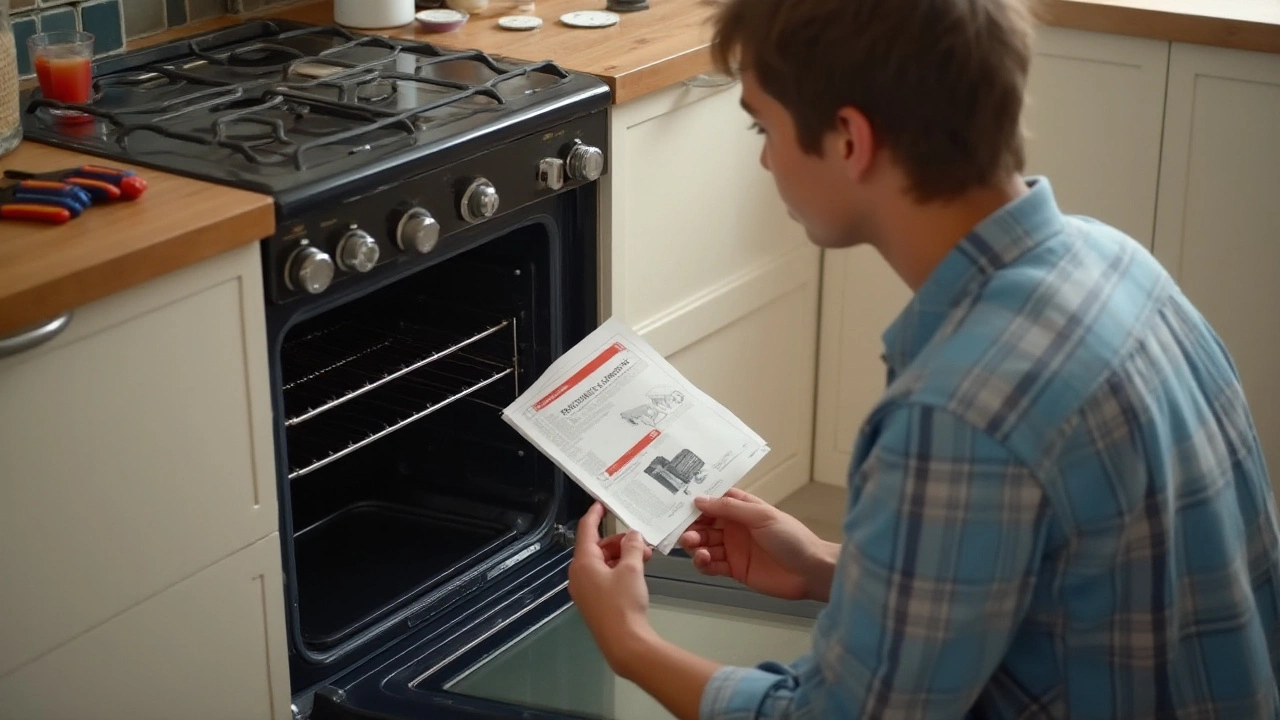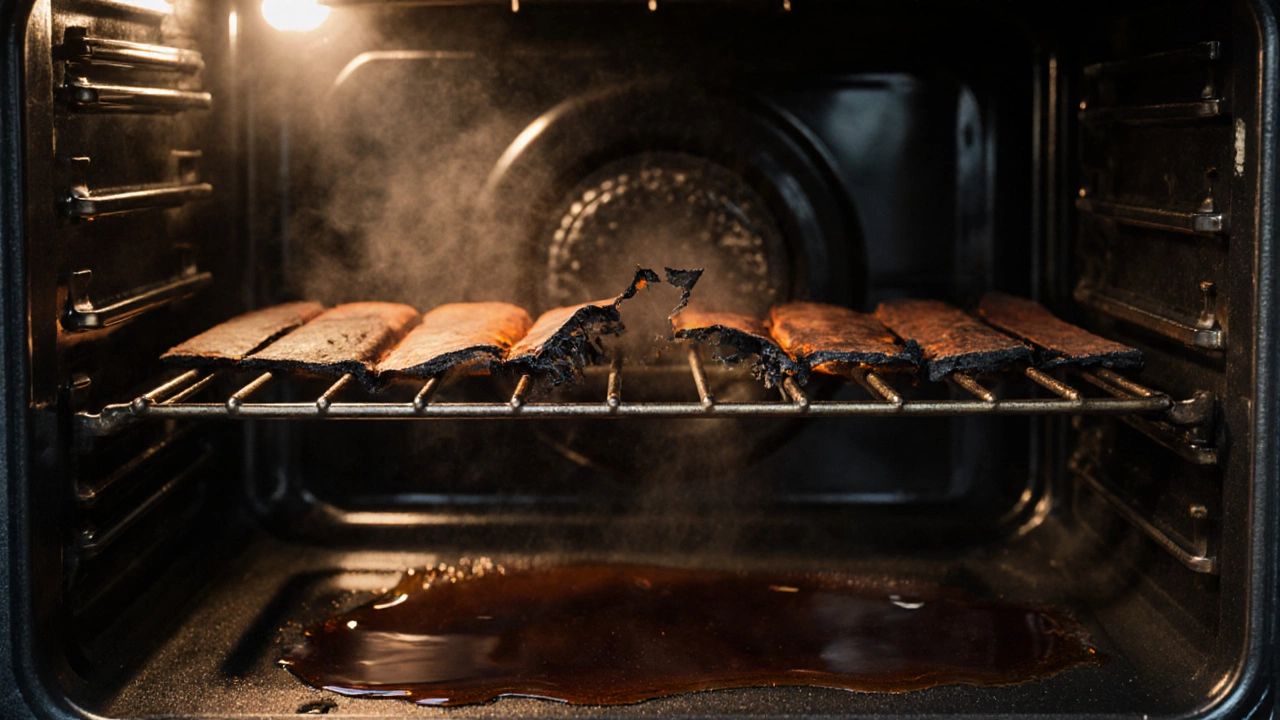
- 19 Oct 2024
- Gideon Thornton
- 0
Replacing an electric oven element might seem like a daunting task, but it's often less complicated than one might think. Whether you're a DIY enthusiast or someone weighing whether to call a professional, understanding the costs involved is essential. Many factors can influence the overall expense, including the type and brand of the oven, the price of the replacement part, and whether you decide to hire help.
While the heart of any oven lies in its element, subtle signals like uneven cooking or complete failure can hint that it's time for a change. Armed with the right information, tackling this repair can save on both time and money. Let's dive into the nitty-gritty of what you should expect costs-wise and how you can manage this repair with ease and safety.
- Understanding the Function of the Oven Element
- Signs That Your Oven Element Needs Replacement
- Parts and Tools Required
- Cost of DIY vs Professional Replacement
- Tips for Choosing the Right Replacement Element
- Safety Precautions to Consider
Understanding the Function of the Oven Element
An electric oven element is the unsung hero of your kitchen; it turns electricity into heat, turning raw ingredients into delicious meals. Found in both your oven’s top and bottom, these metal wires, nestled inside a robust yet delicate shell, heat up when electric current flows through them. The process may seem straightforward, but it’s quite the marvel of electrical engineering, transforming your appliance into the powerful device it is. Each element, whether the broil or bake variant, fulfills a unique role. The bake element, typically positioned at the bottom, distributes gentle heat for even cooking, making it perfect for dishes requiring long, slow cooking times. Meanwhile, the broil element, perched atop, blasts your food with a more intense heat for browning, adding that crispy layer we all secretly love.
To delve deeper, it helps to appreciate how energy efficient this system is. With advancements in technology, modern electric ovens can heat fairly quickly, maintaining steady temperatures without massive consumption. This is where the magic occurs; the element adjusts its heat based on the thermostat’s command, ensuring it doesn’t waste energy while achieving that culinary precision. With this in mind, it’s worth noting that a faulty element can disrupt this balance, making your oven consume more power or heat unevenly.
"The essence of an electric oven's function lies in the meticulous transformation of energy, which is paramount for achieving prepared meals with perfect consistency," says Dr. Charles Anderson, a renowned culinary scientist.
When considering replacing an oven element, it’s crucial to remember that each model may present minor variations. Some might have hidden elements, lending a seamless look to the oven’s interior, while others have exposed ones, which ease immediate heat transfer. Avoiding automatic assumptions like one-size-fits-all is key to ensuring efficient repairs. Recognizing the specific demands of your appliance will go a long way in maintaining its optimal function.
To sum it up, the oven element stands as more than a simple piece of metal; it’s the powerhouse within your kitchen staple. Appreciating it comes from seeing it as integral to every flavorful bake and every sizzling roast. Realizing its value offers a more informed approach to any repair or replacement, ensuring your cooking experience is second to none.
Signs That Your Oven Element Needs Replacement
Understanding when your electric oven's element needs replacing often begins with observing its performance. One of the most common indicators is the oven's inability to reach or maintain the desired temperature. This can often be attributed to the oven element not heating properly. It's frustrating when you set the temperature dial, and yet, your food comes out undercooked or unevenly baked. Such inconsistencies can ruin not just a meal but also your mood.
Another tell-tale sign lies in the appearance of the element itself. If you see any visible damage such as splits, blisters, or burns, it's likely a sign that replacement is necessary. These visible symptoms often signal that the element has reached the end of its life. Constant use, over time, causes wear and tear on the element's metal coils. An occasional burnt smell when the oven is on, though it could be mistaken for food remnants, can actually be a sign of a failing element as well.
One more subtle but critical indicator can be an unexplained spike in your electricity bills. This is usually because the element is working inefficiently, pulling more power than usual to attempt maintaining the required heat. Be observant and if you notice such spikes alongside other signs, it might be time for a check. Sometimes, you may even hear a buzzing noise when the oven is on, which is not typical. Often, such noise comes from a faulty oven element struggling to perform.
There are times when an oven simply stops working entirely, not heating up at all. Though several components could be at fault, such as the thermostat, one of the first components to check is the oven element. Such problems may sound simple, yet they need swift address to restore normality. Interestingly, a survey conducted among home appliance users found that nearly 65% of oven failures stem from faulty elements.
It’s always worth checking the oven’s manual for any troubleshooting tips offered by the manufacturer. This can sometimes provide insight into specific signs unique to your oven model. Moreover, being proactive about maintenance can prolong the life of your oven element. Regularly cleaning the oven and ensuring there’s no residue build-up on the element can aid in keeping it functioning correctly.
According to the Home Appliance Manufacturers Association, "Routine checks and maintenance can extend the lifespan of oven elements significantly, often saving homeowners from unnecessary replacements."
If the signs are there and they seem glaring, it's best not to delay replacement. Addressing the issue early not only ensures a well-functioning oven but also saves energy and cost. Whether you decide to tackle the replacement as a DIY project or call in a professional, these signs are your first step in diagnosing the issue effectively.

Parts and Tools Required
When the time comes to replace an electric oven element, gathering the right parts and tools is crucial to ensure a smooth process. The most pivotal component you'll need is, naturally, the replacement oven element itself. It's essential to match the new element with the make and model of your oven as not all are universally compatible. Before heading out to buy one, it's worthwhile to consult your oven's user manual or search for parts online using the model number to avoid unnecessary returns or exchanges.
Beyond the primary part, several tools can aid immeasurably in the replacement process. A sturdy screwdriver is indispensable, often a Phillips head, but some models might require a flathead. It's wise to carry both to avoid interruptions. Having a set of pliers on standby is also recommended. They're handy for adjusting any connectors that might be stubborn or need realignment. In addition to those, a multimeter can be extremely beneficial, especially if you wish to double-check the element's connectivity before installing it. Using it to test the element for continuity ensures it's not a manufacturing dud.
An occasionally overlooked but still important add-on is a small flashlight or work light. Ovens can be dimly lit, and the human eye struggles without sufficient light, particularly when dealing with small screws. Don't forget safety either. A pair of sturdy gloves is worth their weight in gold. They not only keep your hands safe from sharp edges but also add a layer of protection against any unexpected electrical jolts. Here's a tip from the DIY community: always keep a towel or rag nearby. It sounds simple, but unexpected residues from old elements or accumulated dust can create quite the mess.
Ensuring that you have all the necessary parts and tools at your disposal can turn what might seem like a challenging task into an efficient and fulfilling one. Ideally, it would help if you laid everything out before you start, like a chef preparing ingredients for a dish. This foresight dramatically reduces the time-wasted searching and rummaging once the stove is in bits. As the author Ken Denmead of 'Geek Dad' fame once advised, "Preparation isn't half the battle; it's the whole war."
"It's the little details that make all the difference," he further commented, underscoring the importance of planning ahead.
For those who appreciate an extra bit of guidance, some users find it exponentially helpful to jot down step-by-step notes before diving in, often referring to online tutorials or videos for visual aid. This can be especially comforting for those new to appliance repairs or for those of us who prefer leaving no stone unturned. After all, successfully replacing an electric oven element is not just about skill; it's about being adequately prepared and confident in the steps you're about to take.
Cost of DIY vs Professional Replacement
Deciding between a DIY project or hiring a professional can be tricky, especially when it comes to replacing an electric oven's element. Both approaches have their merits, and understanding the potential costs involved is crucial. For those who are handy with tools and relish the satisfaction of a job done by their own two hands, a DIY replacement can be quite the adventure. The major draw is often the cost savings. Typically, purchasing a replacement heating element will set you back anywhere between £20 and £50, depending on the brand and model of your oven. This route allows you to sidestep hefty labor fees, which can account for nearly half of the total cost when a professional is involved. But it's important to remember that doing it yourself isn't just about buying the right part—it requires some time, patience, and a basic set of tools.
There's also the professional route, a comforting choice for those who may not feel fully confident in their DIY skills or simply prefer not to tinker with electrical appliances. Depending on your location and the specific service provider, hiring a professional to replace your oven element can cost anywhere from £100 to £150, sometimes even more. Labor charges can vary widely, but they often include a guarantee of quality work, saving you from any potential mishaps that could occur in a DIY attempt. An experienced technician will not only take care of the replacement efficiently but can also offer valuable advice on maintenance to help prolong the life of your oven. Indeed, as Winston Churchill once fittingly noted,
"Success always demands a greater effort." Opting for professional help might indeed reflect a greater financial outlay, but it often ensures success without the added stress.
When contemplating which path to choose, one must consider not just the obvious monetary costs, but the less tangible aspects as well. These include the time commitment involved, the peace of mind gained from a completed job, and the potential learning curve of acquiring new DIY skills. Certain ovens, especially older or high-end models, might require specific components or technical skills, nudging the decision towards professional help. A small mistake in a DIY effort could inadvertently lead to further damage and increased costs, so weighing these factors is vital. While you might pay more upfront by hiring a professional, the assurance of a job well done can sometimes be invaluable, preventing unexpected expenses down the line. Whether opting for self-reliance or professional expertise, understanding both avenues will steer you towards a decision that best suits your needs and circumstances.

Tips for Choosing the Right Replacement Element
When it comes to replacing an electric oven element, selecting the appropriate part is crucial for ensuring that your oven functions efficiently. Although it might seem straightforward, there are intricacies involved that can make the difference between a quick fix and a persistent kitchen nightmare. The first step is identifying the brand and model of your oven. This information is typically found on the inside of the oven door or on a plate located on the frame. Once you have this, you can search for compatible elements. Keep in mind that buying directly from the manufacturer often guarantees compatibility, though it might be pricier.
Next, consider the wattage of the replacement element. This is crucial since an element with lower wattage may take forever to heat up, affecting cooking times and consistency. Conversely, a higher wattage element can lead to energy inefficiency and potentially burn out sooner. Consult your oven's manual or manufacturer website for specifications. As a rule of thumb, the wattage of the replacement should match the original unless advised otherwise by a professional. Additionally, be mindful of the configuration of the replacement element—it should resemble the original in shape and size to ensure it fits snugly without issue.
While sourcing the element, it's wise to shop around. Online retailers often provide a plethora of choices at competitive prices. However, don't bypass local appliance stores where you can physically inspect the product. Speaking with experienced store technicians can glean insights you might not find online. A quote from Owen Peters, a veteran appliance repairman, suggests,
"Choosing the right oven element is like fitting a new heart into a body. It’s got to be just right, or nothing will work as it should."This analogy underscores the importance of precision and compatibility.
Another critical factor is the warranty. A good warranty on parts is indispensable. It indicates that the manufacturer stands by their product, giving you peace of mind. Some warranties can cover defects for up to a year, which is an asset when dealing with frequent cooks or heavy-duty ovens. Before making a purchase, check the return policy too. Sometimes elements shipped out differ slightly from their descriptions, and having a flexible return policy ensures you won't be stuck with an unusable part. Ultimately, investing time and effort into choosing the right replacement element saves not just money, but also the hassle associated with repeated repairs.
Safety Precautions to Consider
When embarking on the task of replacing an electric oven element, it’s crucial to prioritize safety. The very nature of dealing with electrical components and appliances necessitates a certain level of caution. First and foremost, ensure the oven is completely turned off and unplugged from the power source before beginning any repair work. This may sound like a simple step, but its importance cannot be overstated. Many unfortunate incidents have occurred because people forgot to disconnect the appliance, leading to electrical shocks or even worse.
Equally important is the importance of wearing appropriate personal protective equipment. Consider investing in a pair of sturdy work gloves and safety goggles. These will protect your hands from sharp edges and your eyes from any unexpected sparks. An often overlooked fact is that some ovens may have retained heat for a significant period even after being turned off. Thus, always make sure the appliance has cooled down completely before handling any of its parts. This might seem like common sense, but you'll be surprised at how often haste leads to harm.
As the safety officer at DIY SOS says, "Preparation and precaution are two halves of the same coin when it comes to home repairs."
Getting the right tools is vital when replacing an oven element. Make sure you have a screwdriver suited for the screws of your appliance, and remember to handle them with care. Some appliances might require specific tools that you may not have lying around. It might be worth a trip to a hardware store or borrowing from a neighbor rather than using makeshift tools that could easily slip or break, possibly injuring you in the process.
Organizing the workspace efficiently is another safety measure that’s often underestimated. Clear away any clutter and ensure you have adequate lighting. You may be working with small screws and components, so ensuring a well-lit area can help in preventing errors and frustration. If you have children or pets, let them know to keep away while you’re working, or better yet, work in a separate area where you won’t be disturbed or endanger them unintentionally.
If, at any point, you feel unsure or uncomfortable with the task, do not hesitate to call a professional. It’s better to err on the side of caution than to risk injury or damage. Many electric oven manual guides advise users to consult a professional if they're not confident, and it's advice worth heeding. Safety isn't just about completing the task without injuries; it's about doing so confidently and effectively.



